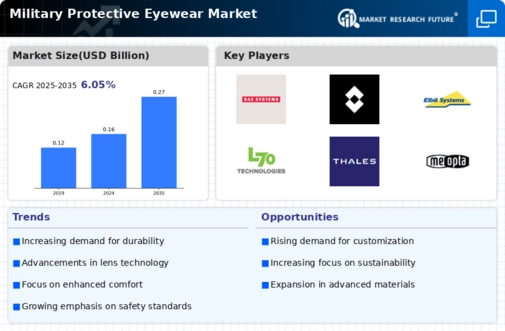Market Growth Projections
The Global Military Protective Eyewear Market Industry is projected to experience substantial growth in the coming years. The market is expected to reach 0.16 USD Billion in 2024 and is anticipated to grow to 0.27 USD Billion by 2035. This growth trajectory suggests a robust demand for military eyewear driven by various factors, including technological advancements and increased military expenditure. The projected CAGR of 4.92% from 2025 to 2035 indicates a sustained interest in protective eyewear solutions that meet the evolving needs of military personnel. As the market expands, it is likely to attract new players and foster innovation.
Technological Advancements
Innovations in materials and design are driving the Global Military Protective Eyewear Market Industry forward. The introduction of lightweight, durable materials, such as polycarbonate and advanced coatings, enhances the functionality and comfort of eyewear. These advancements not only improve vision clarity but also provide superior impact resistance. As military operations become more complex, the need for eyewear that can withstand extreme conditions becomes paramount. The integration of smart technologies, such as augmented reality features, is also emerging, potentially revolutionizing how soldiers interact with their environment. Such innovations are likely to attract investments and boost market growth.
Increased Military Expenditure
The Global Military Protective Eyewear Market Industry is experiencing growth due to rising military budgets across various nations. Governments are prioritizing defense spending, which has led to increased procurement of advanced protective gear, including eyewear. For instance, in 2024, the market is projected to reach 0.16 USD Billion, reflecting a commitment to enhancing soldier safety. Countries like the United States and China are leading in military expenditure, which directly influences the demand for high-quality protective eyewear. This trend is expected to continue, as military forces seek to equip personnel with the best possible protection against environmental hazards.
Rising Awareness of Eye Safety
There is a growing recognition of the importance of eye protection in military operations, which is significantly impacting the Global Military Protective Eyewear Market Industry. Training programs emphasizing the risks of eye injuries and the benefits of protective eyewear are becoming commonplace. This heightened awareness is leading to increased demand for specialized eyewear that meets military standards. As a result, manufacturers are focusing on developing products that not only comply with safety regulations but also offer comfort and style. This trend is expected to contribute to the market's projected growth, with estimates indicating a rise to 0.27 USD Billion by 2035.
Global Conflict and Security Threats
Ongoing global conflicts and emerging security threats are pivotal drivers of the Global Military Protective Eyewear Market Industry. As geopolitical tensions rise, nations are compelled to enhance their military capabilities, which includes investing in protective gear for personnel. The need for effective protective eyewear is underscored by the increasing frequency of military engagements and the evolving nature of warfare. This environment fosters a demand for advanced eyewear solutions that can protect against various threats, including ballistic impacts and environmental hazards. Consequently, the market is poised for steady growth, with a projected CAGR of 4.92% from 2025 to 2035.
Government Regulations and Standards
The Global Military Protective Eyewear Market Industry is influenced by stringent government regulations and standards regarding military equipment. Compliance with safety standards is essential for manufacturers, as military contracts often require adherence to specific guidelines. These regulations ensure that protective eyewear meets the necessary performance criteria, thereby enhancing soldier safety. As governments continue to enforce these standards, manufacturers are incentivized to innovate and improve their product offerings. This regulatory environment not only drives market growth but also fosters competition among manufacturers to develop superior eyewear solutions that align with military requirements.



















Leave a Comment